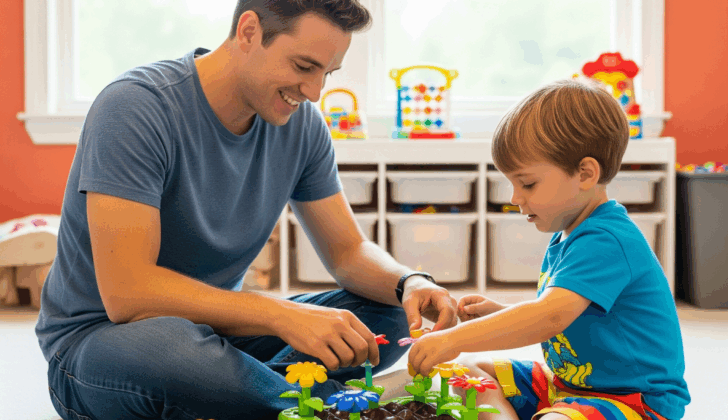Does your child say “fower” instead of “flower” or “ashlight” instead of “flashlight”? If so, they may be having trouble with the /fl/ blend, and that’s okay! This article will walk you through what this blend is, when it usually develops, and easy, playful ways to help your child practice it at home.
What Is the /fl/ Blend?
The /fl/ blend is a combination of two consonant sounds—/f/ and /l/—spoken together smoothly, like in “flower”, “flag”, or “flip.” These blends can be tricky for young children, especially if they’re still learning how to move their tongue and lips precisely.
When Should My Child Be Able to Say /fl/ Words?
Most children begin producing /f/ sounds correctly around age 5 to 7. If your child is younger and still working on it, that’s totally normal. If they’re 6 or older and consistently dropping the /f/ or /l/ in words like “flip,” gentle practice at home can help support clearer speech.
How Do You Make the /fl/ Sound?
Here’s a simple breakdown of how to help your child say the /fl/ blend:
- Start with the /f/ sound: I like to call this sound the “mad cat” sound. Like a cat showing it’s teeth and hissing. When making this sound, bite your bottom lip gently and blow out air—like a quiet puff: “ffff.”
- Then quickly move to the /l/ sound: I like to call this the “singing” sound, like la la la. When making this sounds, the tongue tip lifts to touch the bump behind the upper front teeth (the alveolar ridge): “llll.”
Put it together slowly at first: “ffff…llll… flower!”
🗣 Parent Script:
“Let’s make a quiet blowing sound like this—fffff. Now let your tongue touch up high for lllll. Put them together—ffffllll—flower!”
Fun Activities to Practice the /fl/ Blend
Practicing speech sounds doesn’t have to feel like work! Here are some playful ways to target the /fl/ sound during everyday activities and play.
1. Blow and “Flow” Game
What You Need: Pom poms or cotton balls and a straw
Amazon Idea:Colorful Pom Poms, Silicone reusable Straws
Have a “blow race” by blowing pom poms across the table or floor and talk about how they “flow.”
🗣 Try This Script:
“Let’s blow the pom pom and watch it flow across the table! Can you say ‘flow’ with me? Ffffllllow!”
2. Flower Planting Pretend Play
What You Need: Toy flowers or real ones to plant
Amazon Idea:Flower Garden Set
Plant and pick pretend flowers together. Use words like “flower,” “plant,” “flop,” and “flip.”
🗣 Try This Script:
“Let’s plant this flower. Dig, dig, dig… now press it in. You try, ‘flower’—fffflower!”
3. Flip and Find Game
What You Need: Cards or small pictures placed face-down
Amazon Idea:Picture Flashcards
Have your child “flip” over a card and name the picture. You can make your own cards with /fl/ words like: flag, flip, float, flower, flute, flea, flame.
🗣 Try This Script:
“Flip the card and tell me what you see. Oh, it’s a flag! Can you say ‘flag’ with your /fl/ sound?”
4. Bubble Play – “Float” and “Fly”
What You Need: Bubbles
Amazon Idea:Bubble Machine, Bubbles
Watch the bubbles “float” and “fly” through the air as you pop them. Say the words as you play.
🗣 Try This Script:
“Look at the bubbles float! Your turn, ‘float’? Let’s pop them before they fly away!”
Easy Ways to Practice /fl/ in Daily Life
You can practice the /fl/ blend during your regular daily routines! Here are some ideas to sneak in speech practice:
Getting Dressed
- “Let’s put on your flip-flops!”
- “This shirt has flowers!”
- “Time to fluff your pillow!”
Bath Time
- “Watch the bubbles float!”
- “Let’s flip the toy over.”
- “Flap your arms like a duck!”
Reading Time
Choose books with /fl/ words and pause to repeat them slowly with your child.
Amazon Idea: The Tiny Seed Book (talk about how flowers grow)
Tips for Parents
- Always model first: Say the /fl/ word slowly and clearly before asking your child to try.
- Keep it fun: Turn practice into a game or part of pretend play.
- Praise effort: Even if the sound isn’t perfect yet, say “Nice try!”
- Use visual or hand cues: You can move your hand forward like a wave to show the blend “flowing” together.
🗣 Common /fl/ Words to Practice
- Flower
- Flip
- Flop
- Flag
- Flame
- Float
- Fly
- Flute
- Fluffy
- Flap
Final Thoughts
Helping your child learn new speech sounds doesn’t have to be boring or stressful. With a few creative ideas and some playful language, you can support their development in ways that feel natural and fun. Whether you’re flipping cards, planting flowers, or blowing bubbles, remember: what matters most is connecting with your child and celebrating every bit of progress along the way. Hearing correct productions of this sound is a very helpful strategy by itself.
And if your child continues to struggle with blends or other speech sounds, a certified speech-language pathologist can help provide individualized support.
Keep Learning & Stay Connected
Follow First Words Bright Futures on Facebook and Instagram for:
-
Daily speech tips
-
Fun activity ideas
-
Q&A with a pediatric SLP
Explore More:
- MDS: Bouncing into the /B/ Sound: Fun Home Strategies for Boosting Your Child’s Speech
- MDS: Hiss Happens: A Parent’s Guide to Helping Your Child Master the /s/ Sound
Disclaimer: This article offers general educational information. It is not a substitute for professional evaluation or treatment. Please consult a licensed Speech-Language Pathologist for personalized concerns regarding your child’s speech development.












